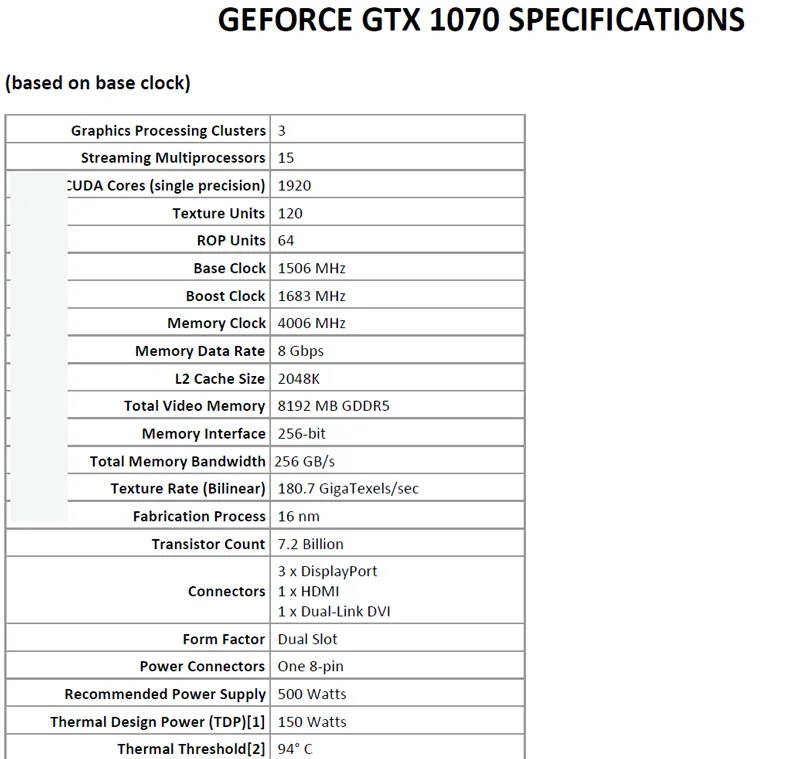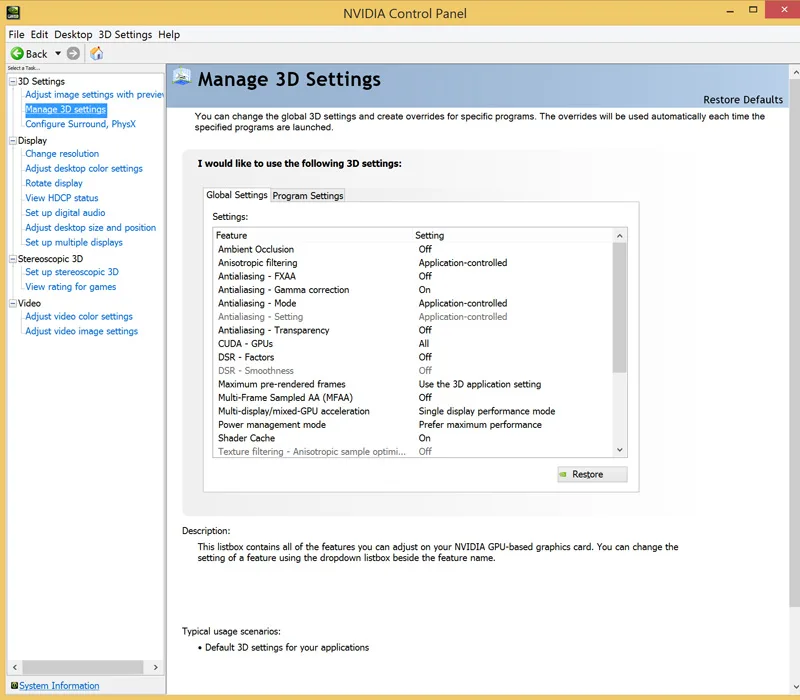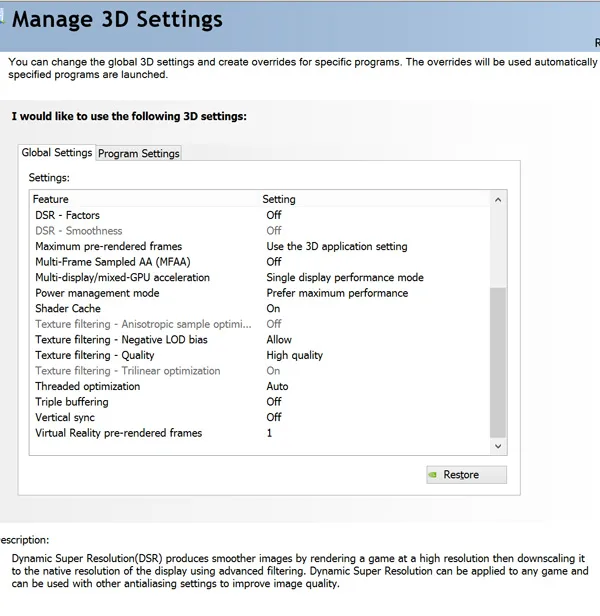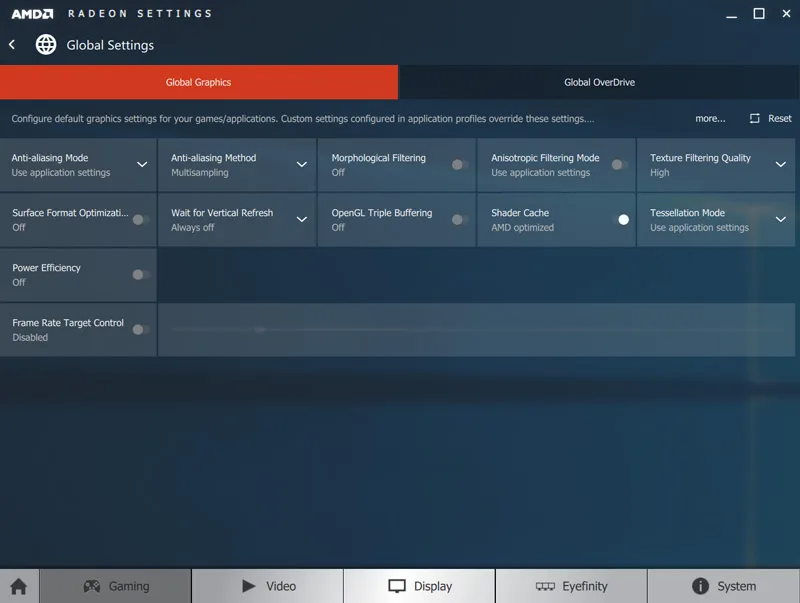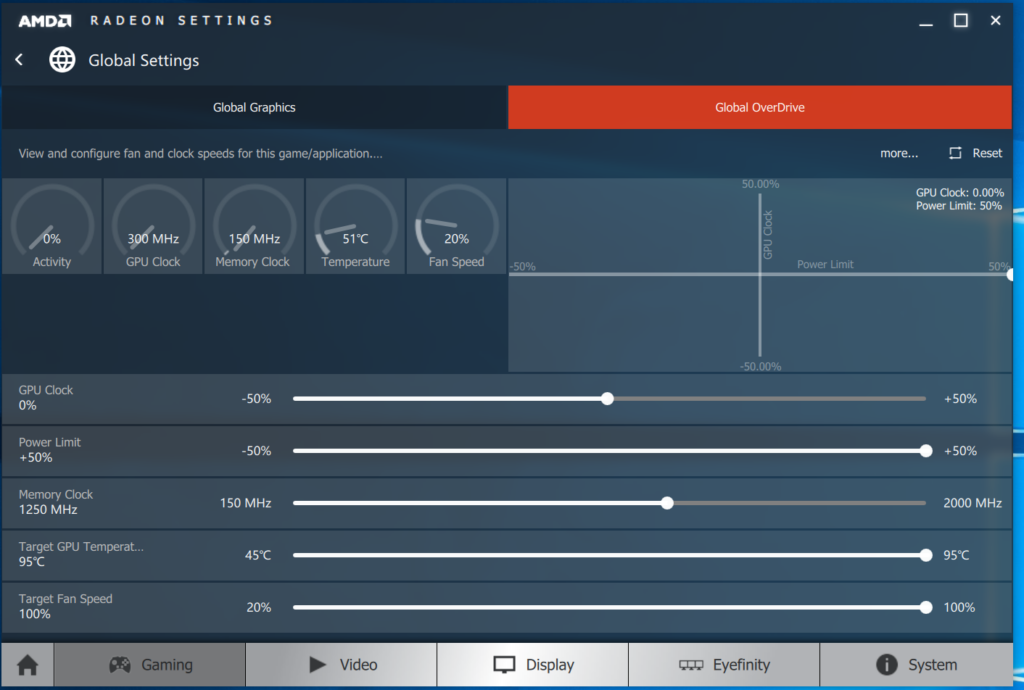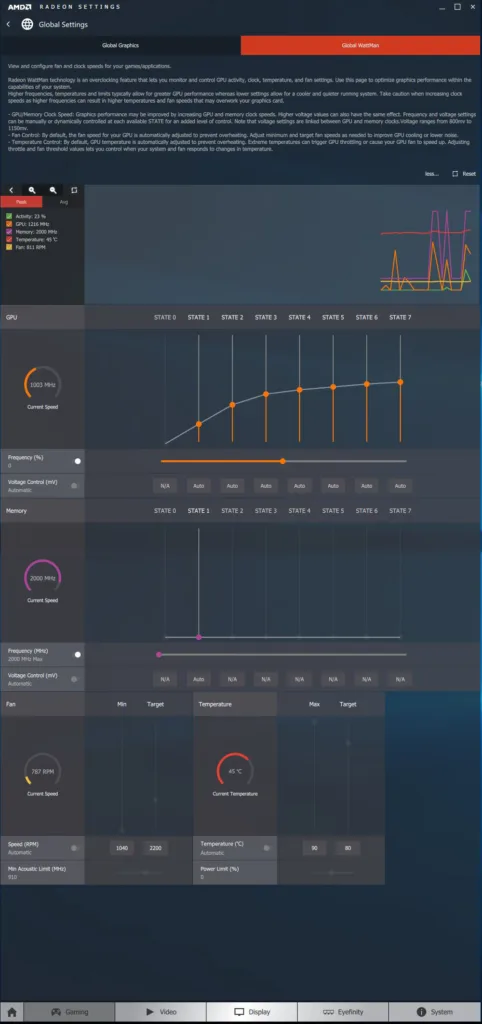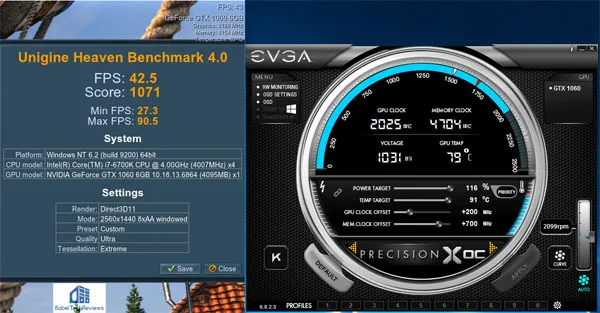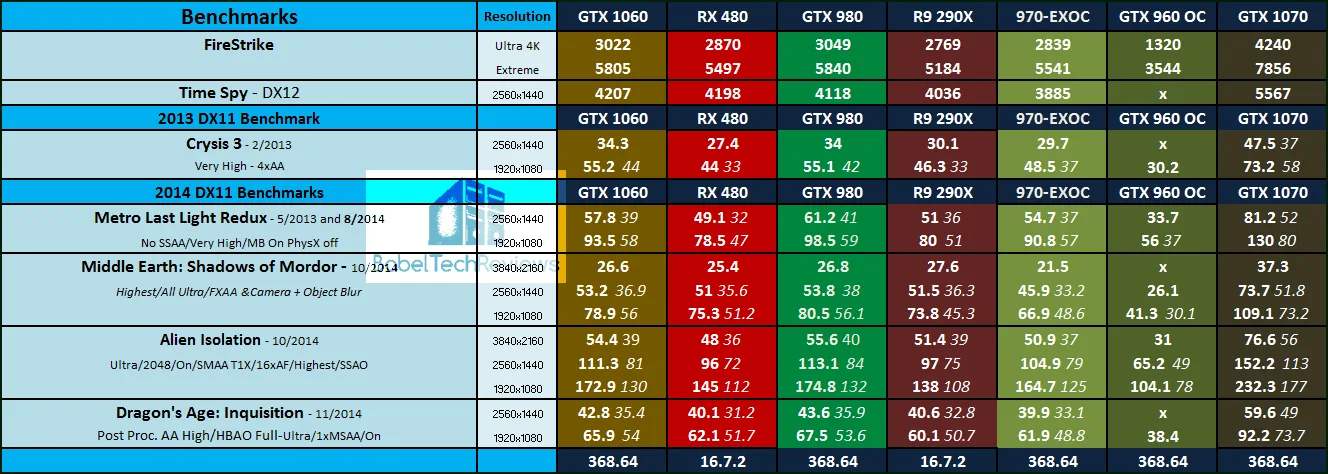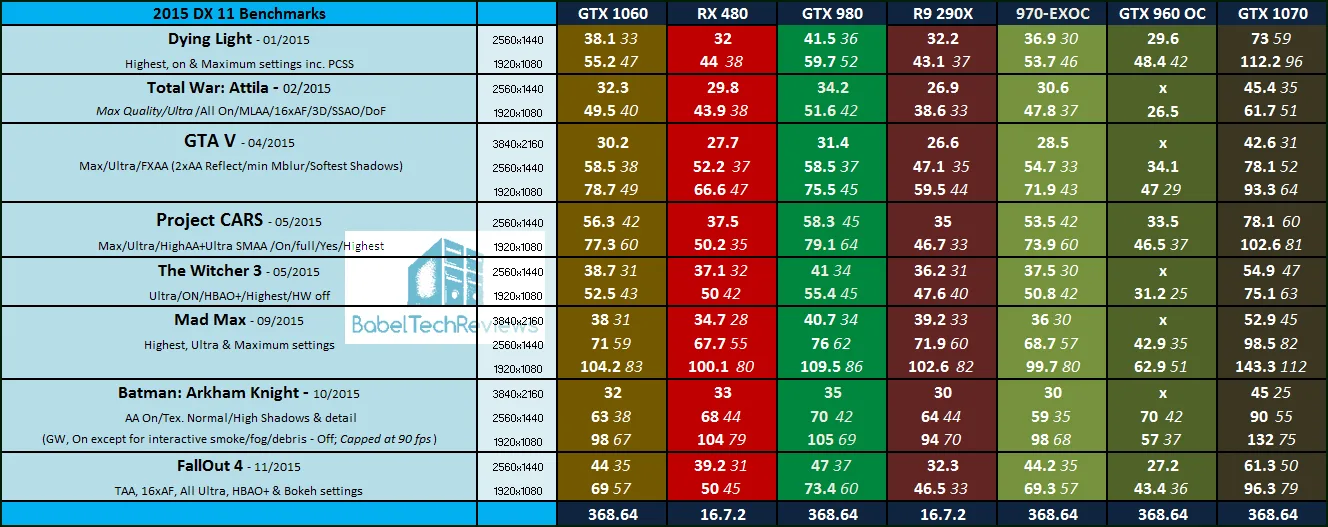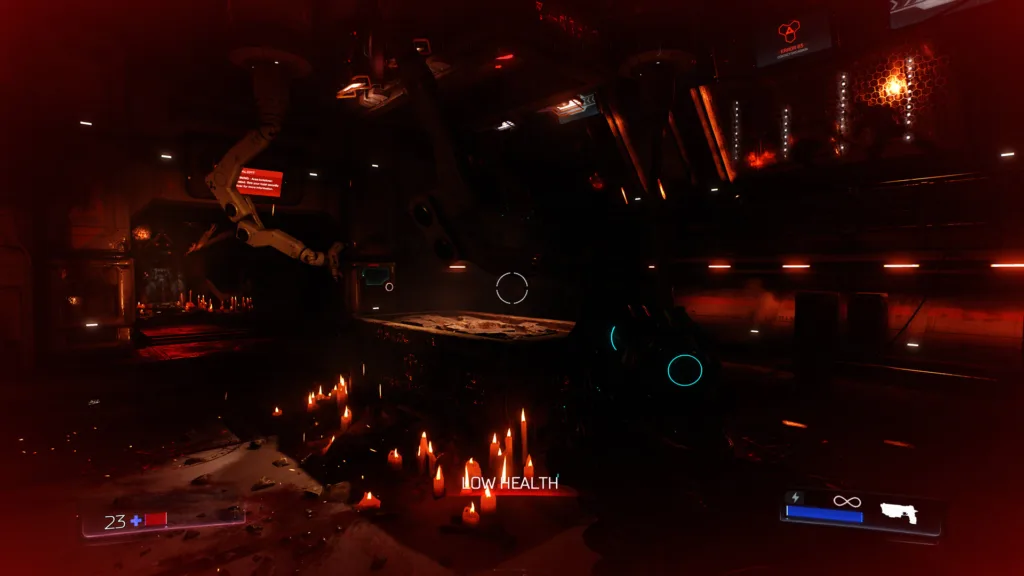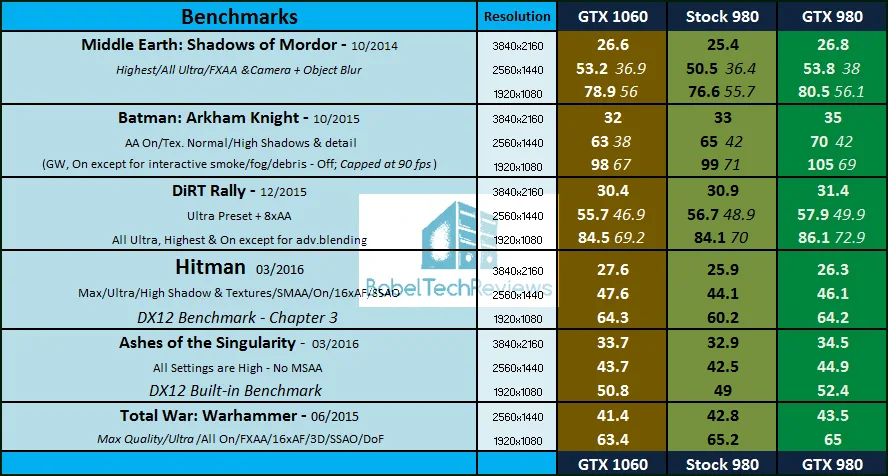The GeForce GTX 1060 is Nvidia’s third GPU based on 16nm Pascal architecture. It is very similar to the GTX 1070 that we reviewed at the end of May although it is less powerful. It is also considerably less expensive compared with the GTX 1070 which launched at $459 for the reference Founders Edition, or at $379 for entry-level partner cards. The GTX 1060 is priced starting at $249, or at $299 for the built by Nvidia reference Founders Edition that we are testing today, and they will be available for purchase today, on July 19. The GTX 1060 will compete directly with AMD’s RX 480 8GB which retails for $239.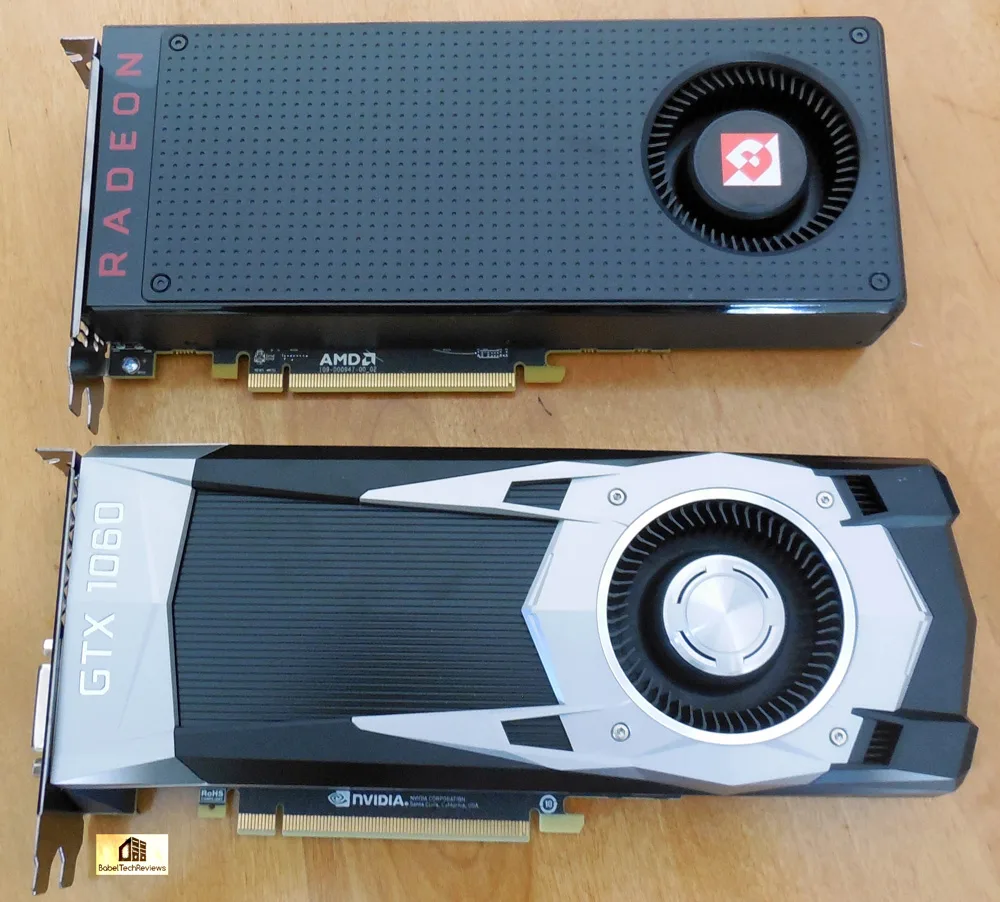
Instead of repeating all of the same information in our GTX 1080 and GTX 1070 launch reviews, we are going to highlight the differences between them and the GTX 1060, and then we will benchmark it against a similar but completely updated benching suite to see just how capable it is. We are going to compare its performance with that of its rivals, the AMD RX 480 and the 290X, as well as against the GTX 980, the GTX 970 EXOC, and we will see how close it can get to the much more expensive GTX 1070. We also want to compare it with the GPU it is replacing, a factory overclocked Maxwell ASUS Strix GTX 960 OC 2GB – which launched last January for $209 – to see if it is a worthy upgrade.
The GTX 1070 is based on the same GP104 GPU used in the GeForce GTX 1080, but the GeForce GTX 1060 is based on an all new Pascal GPU, GP106. It supports all of the same new features that Nvidia’s Pascal architecture brings. They all deliver high clock speeds while using relatively little power – the GeForce GTX 1060 runs over 1.5 GHz with a TDP of just 120 watts. Pascal’s 16nm manufacturing process allows the GTX 1060 GPU to perform faster than Maxwell generation GPUs giving GeForce GTX 1060 a huge performance lead over the GeForce GTX 960.
Nvidia also claims that the GTX 1060 will be on average 15 percent faster and over 75 percent more power efficient than their competitor’s RX 480, and it is said to deliver a GTX 980 level of performance. The GTX 1060 is also supposed to be an excellent overclocker, able to reach 2GHz which we shall also test at stock voltage and fan profile today.
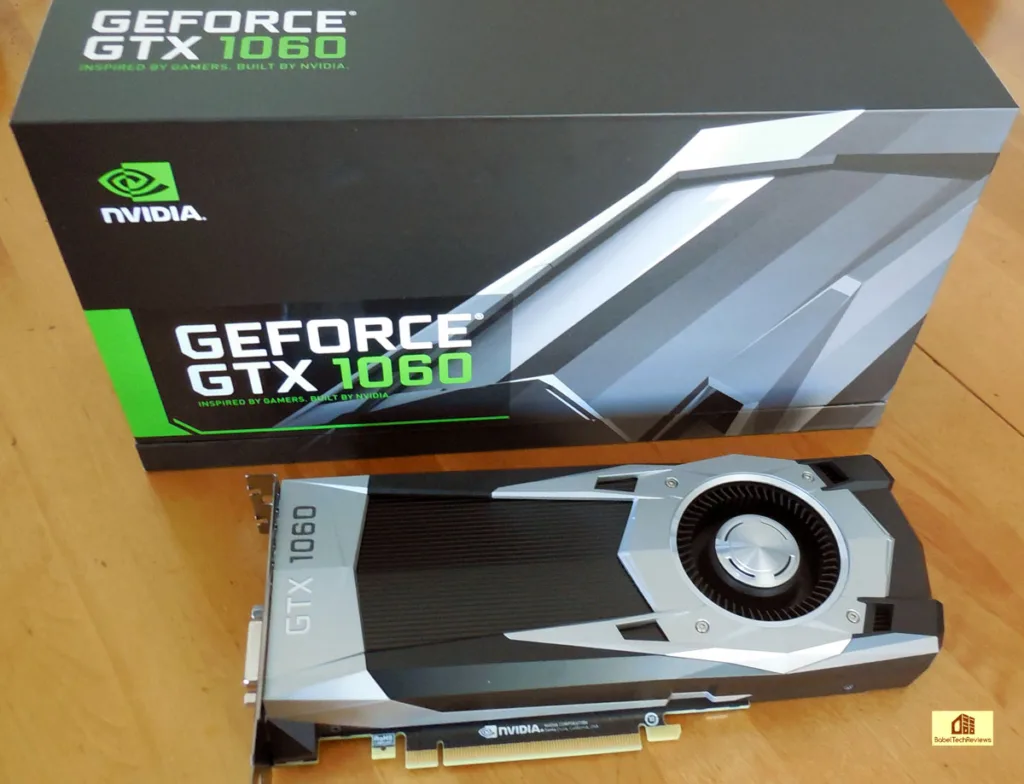 BTR received a GTX 1060 Founders Edition from Nvidia, and for the past week we have put it through its stock and even some preliminary overclocked paces with our updated 26-game PC benchmark suite. Our testing platform is Windows 10 Home 64-bit, using an Intel Core i7-6700K at 4.00GHz which turbos to 4.4GHz for all cores as set in the ASRock Z7170 motherboard’s BIOS, and 16GB of G.SKILL DDR4 at 3200MHz. The settings and hardware are identical except for the drivers being tested.
BTR received a GTX 1060 Founders Edition from Nvidia, and for the past week we have put it through its stock and even some preliminary overclocked paces with our updated 26-game PC benchmark suite. Our testing platform is Windows 10 Home 64-bit, using an Intel Core i7-6700K at 4.00GHz which turbos to 4.4GHz for all cores as set in the ASRock Z7170 motherboard’s BIOS, and 16GB of G.SKILL DDR4 at 3200MHz. The settings and hardware are identical except for the drivers being tested.
We are also featuring our newest 2016 games, Mirror’s Edge Catalyst and DOOM, and we are also including Ashes of the Singularity, Hitman, and Rise of the Tomb Raider using DX12. We have also added Total War Warhammer’s newly released DX12 built-in beta benchmark to our regular benching suite plus Futuremark’s just released DX12 benchmark, Time Spy. In addition, we have also managed to compare Vulkan versus OpenGL performance in DOOM. We will compare the performance of 26 modern games at 1920×1080, 2560×1440, and at 3840×2160 resolutions with maximum settings.
Specifications and Features of the GTX 1060
Before we give you the results of our performance testing, we want to briefly cover Pascal architecture, as well as detail the specifications and features of the new GTX 1070. Since we benchmark 26 games, we have a much larger benchmark suite than any other English-speaking tech site in the world, so we are going to concentrate on performance and we will only briefly summarize the new features of the GTX 1060.
Features of the Pascal GTX 1060
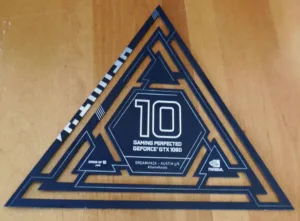 Pascal offers large increases in performance, memory bandwidth, and power efficiency over the current Maxwell architecture. It introduces new graphics features and technologies that confirm the PC as the ultimate platform for playing AAA games and for enjoying virtual reality. All of the features found in the GTX 1080/1070 are also present in the GTX 1060 and we would highly recommend looking back at our GTX 1080 launch article. However, this is a very brief summary:
Pascal offers large increases in performance, memory bandwidth, and power efficiency over the current Maxwell architecture. It introduces new graphics features and technologies that confirm the PC as the ultimate platform for playing AAA games and for enjoying virtual reality. All of the features found in the GTX 1080/1070 are also present in the GTX 1060 and we would highly recommend looking back at our GTX 1080 launch article. However, this is a very brief summary:
Nvidia sums up Pascal’s features as being “the Perfect 10”, this being the GeForce ten series beginning with the release of the GTX 1080, and now, with the GTX 1060.
Nvidia has engineered the Pascal architecture to handle the demanding computing and gaming needs of technologies like VR. It incorporates several new technologies:
- Next-Gen GPU Architecture. Pascal is optimized for performance per watt. The GTX 1080/1070/1060 are about 3x more power efficient than the Maxwell Architecture.
- 16nm FinFET Process. The GTX 1080, the GTX 1070, and the GTX 1060 are designed for the 16nm FinFET process, which uses smaller, faster transistors that are packed together more densely to deliver a significant increase in performance and efficiency.
- Advanced Memory. The GTX 1070 uses 8GB of the fastest available GDDR5 memory at 10000MHz while the GTX 1060 uses GDDR5 memory at 8000MHz. This is a big jump over the 7000MHz memory used in the Maxwell GTX 960.
- Superb Craftsmanship. Increases in bandwidth and power efficiency allow the GTX 1070 and the GTX 1060 to run at really high clock speeds while only using 150 watts and 120 watts of power respectively. New to Pascal is asynchronous compute. And new GPU Boost 3 technology supports advanced overclocking functions.
- Groundbreaking Gaming Technology. New VRWorks software features let game developers bring more immersion to gaming environments. And Nvidia’s Ansel technology lets gamers share their gaming experiences and explore gaming worlds in new ways.
- All Pascal GPUs feature an all-new SMP Engine which is located within the PolyMorph Engine. With this feature, the GPU can simultaneously map a single primitive on up to sixteen different projections from the same viewpoint. It allows Pascal GPUs to accurately match the curved projection required for VR displays, the multiple projection angles required for surround display setups, and other emerging display use cases. In extreme cases, the SMP Engine can reduce the amount of required geometry work by up to 32x!
The next generation of games will not only look better but run faster on the GeForce GTX 1080, the GTX 1070 and the GTX 1060. Nvidia has developed a number of advancements for virtual reality – reducing latency, improving image quality, and bringing a whole range of new content to Virtual Reality.
Pascal GPUs
GP104
First, take a look at the GTX 1080 block diagram which proved to be the world’s fastest GPU..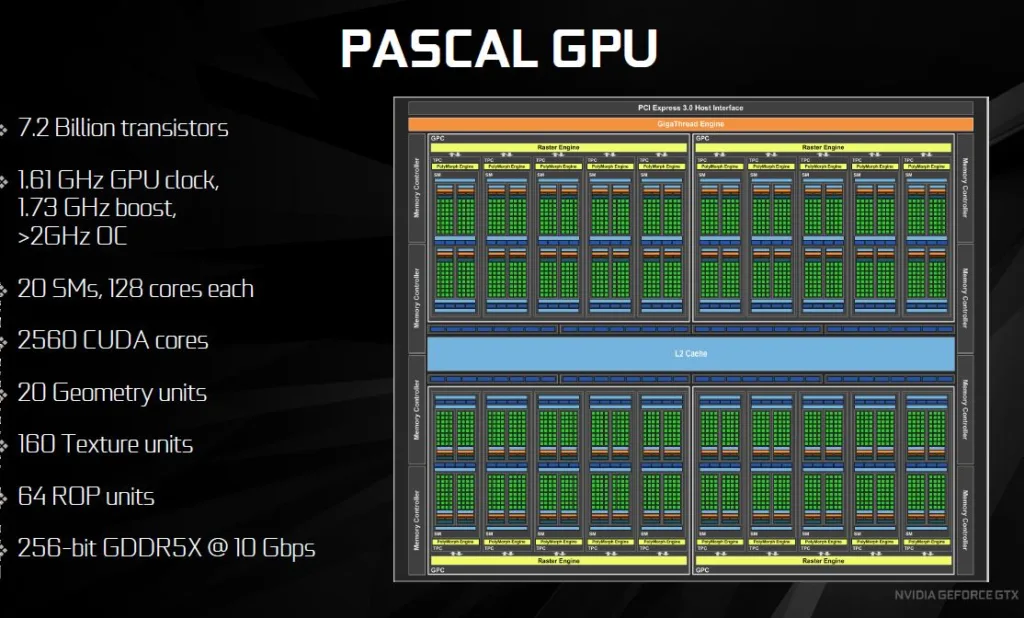
The GTX 1080 GPU has all 4 Graphics Processing clusters enabled with 64 Raster Operating Units, 20 SMs of 128 Cores each totaling 2560 CUDA cores, 20 Geometry units and 160 Texture units. It uses Micron’s 256-bit GDDR5X at 10 Gbps which makes it significantly faster than GDDR5 and its 1.61GHz GPU clock has a boost of 1.73GHz or higher. We also easily managed better than a 1.9 GHz boost clock with complete stability and an offset of +400MHz to its GDDR5X memory (5400MHz).
As befits the slower GTX 1070, it has 3 Graphics processing clusters (one of the GTX 1080’s GPCs are disabled), and it uses 15 Streaming Multiprocessors and 1920 CUDA Cores. The GeForce GTX 1070 runs at a Boost Clock Speed of 1683MHz. Its 120 Texture Units provide a peak texture fill rate of nearly 202 Gigatexels/sec. The memory subsystem of the GeForce GTX 1070 features a fully enabled 256bit memory interface, and ships with 8 Gbps of fast GDDR5 memory, providing up to 256 GB/sec of peak memory bandwidth, but not up to the speeds of the GTX 1080’s GDDR5X. We also managed more than a 200MHz offset to our sample of the GTX 1070’s core with the new Precision XOC and a surprising +500MHz offset to the GDDR5 memory to 4500MHz.
GP106
Now here is the new GP106 GPU which is used for the GTX 1060:
As befits a new architecture, Pascal uses a more advanced and efficient memory compression system. More effective memory compression means a significant savings in bandwidth which make for more efficiency and for faster video cards than Maxwell.
The GTX 1060 features 1,280 CUDA cores, 6GB of GDDR5 memory running at 8Gbps, and a boost clock of 1.7GHz. The GeForce GTX 1060 comes complete with 1280 CUDA Cores and 10 SM units. The memory subsystem of GeForce GTX 1060 consists of six 32-bit memory controllers (192-bit) with 6GB of GDDR5 memory. The base clock speed of the GeForce GTX 1060 is 1506MHz. The typical Boost Clock speed is 1708MHz. The Boost Clock speed is based on the average GeForce GTX 1060 card running a wide variety of games.
Unlike the reference RX 480 which is a poor overclocker because of its weak reference cooler and single 6-pin power connector and 150W power draw, Nvidia says the GTX 1060 can be easily overclocked to 2GHz. We achieved that on stock voltage and fan profile and were able to overclock the memory another 700MHz!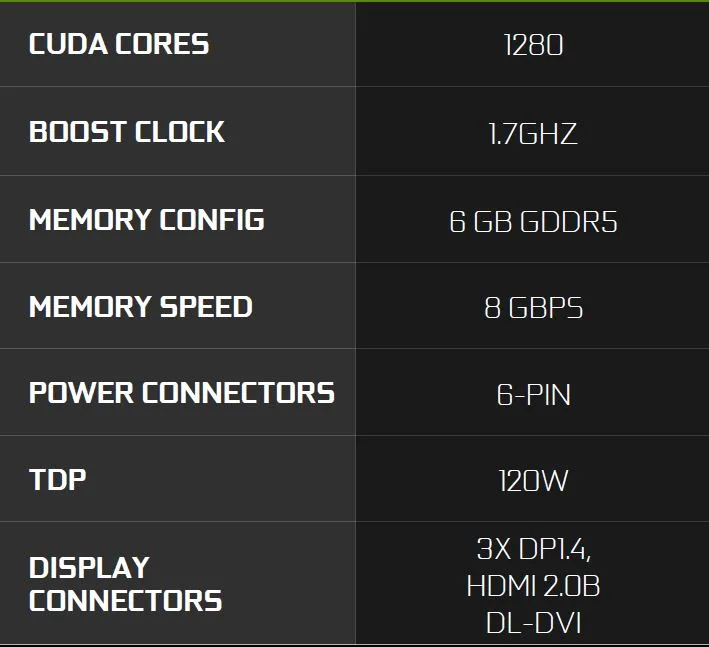
Like the other two Pascal cards, the GTX 1060 includes support for NVIDIA Simultaneous Multi-Projection technology, which allows the GTX 1060 to seamlessly project a single image simultaneously to both eyes, yielding a 3x VR graphics performance improvement over Maxwell GPUs. This allows GTX 1060 users to play VR games with higher levels of detail than similarly performing Maxwell GPUs. Simultaneous Multi-Projection is being integrated into Unreal Engine and Unity, and there are more than 30 games are already in development, including Unreal Tournament, Poolnation VR, Everest VR, Obduction, Adr1ft and Raw Data.
Specifications
Here are the specifications for the GTX 1070:
Now let’s compare with the specifications of the GTX 1060: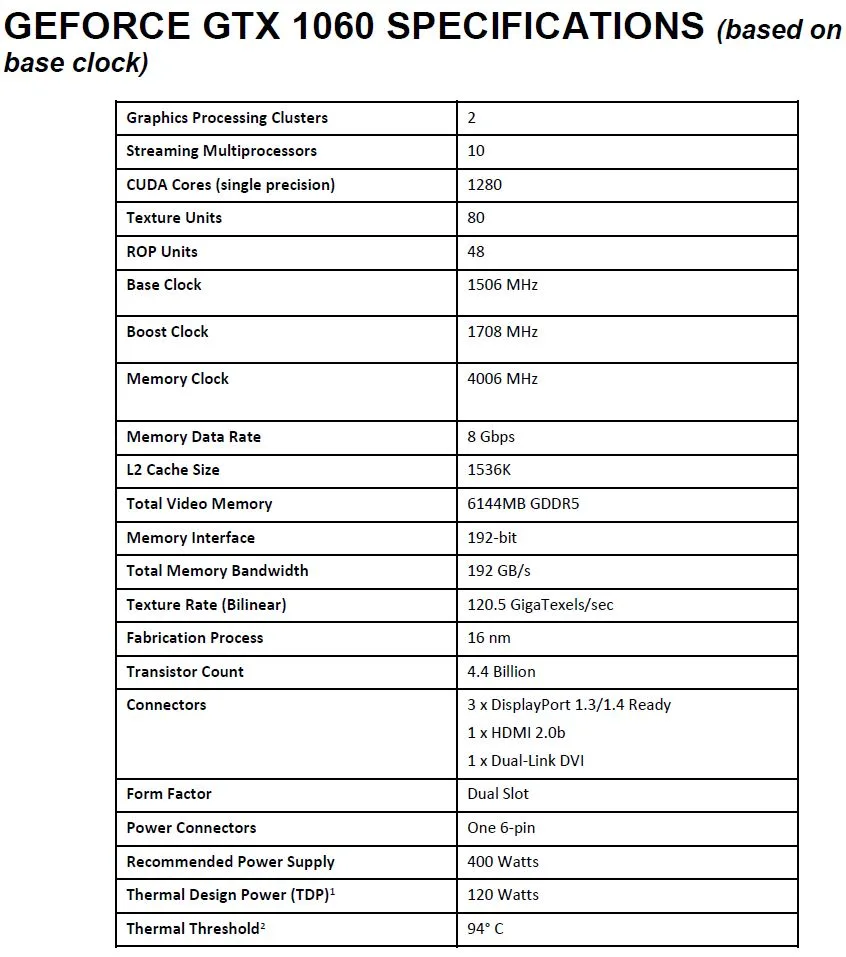
The connectors for the GTX 1060 are identical to the GTX 1080/1070’s: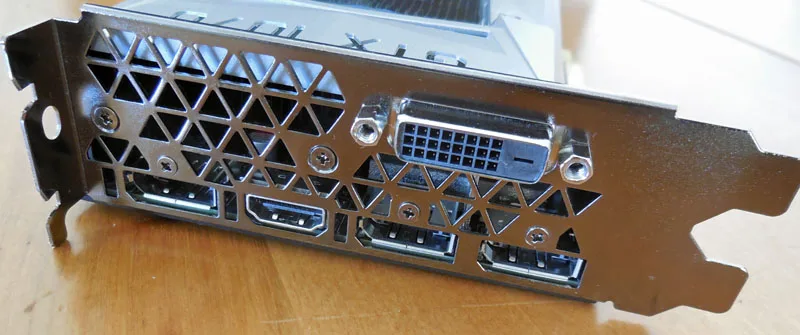
The Founders Edition of the GTX 1070 vs. Partner custom editions
The GeForce GTX 1060 Founders Edition, like the GTX 1080 and the GTX 1070 Founders Editions, are reference graphics card designed and built by Nvidia. The GTX 1060 Founders Edition will sell for $249, $50 more than the base models of the GTX 1060 partner cards. The Founders Edition GTX 1060 will only be available on nvidia.com. It will not be sold by partners or available from etail or retail sites. It was crafted with premium materials and components and it is ideal for situations where air needs to be exhausted out of a case such as small form factor cases.
Custom cards designed by Nvidia’s partners will be the only ones available at etail/retail. The partners have many custom designed boards, including basic models, highly overclocked SKUs, miniature cards, and those with special fans and cooling solutions.
There will be a variety of GTX 1060 cards on newegg.com and Amazon.com including:
- EVGA GTX 1060 Superclocked (SC) Edition: $259
- EVGA GTX 1060 edition: $249
- ASUS STRIX-GTX1060-6G-GAMING: $329
- ASUS Turbo Edition: $249
- PNY GeForce GTX 1060: $259
- MSI GeForce GTX 1060 GAMING X 6G: $289
- MSI GeForce GTX 1060 Gaming 6G: $279
- MSI GeForce GTX 1060 Armor 6G OC: $259
- MSI GeForce GTX 1060 6GT: $249
- Gigabyte GV-N1060G1 GAMING-6GD: $289
- Zotac GeForce GTX 1060 AMP 6GB: $279
- ZT-P10600A-10L ZOTAC GTX 1060 Mini 6G: $249
How does the GTX 1060 compare with the GTX 980 and with their rival, AMD’s new RX 480?
We are going to look at the performance of 26 games to compare the GTX 1060 with the GTX 980, with the GTX 970 OC and with the GTX 1070, and versus the RX 480 and the 290X And of course, we want to see how much the GTX 1060 has progressed over the Maxwell GTX 960 by comparing it with the factory overclocked ASUS Strix GTX 960 OC.
However, before we do performance testing, let’s take a closer look at the GTX 1060.
Unboxing the GTX 1060
The Founders Edition of the GTX 1060 arrives in a sturdy box which can also be used for display.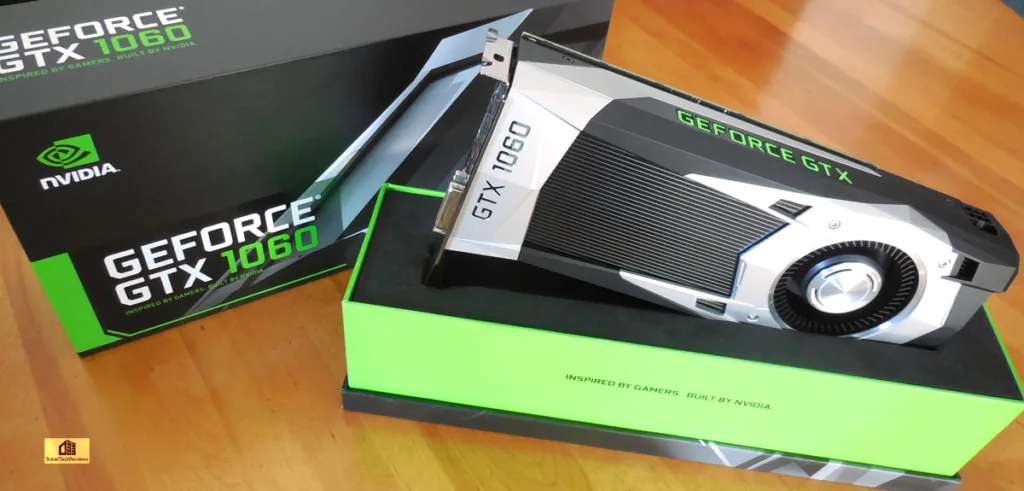
The GeForce GTX 1060 Founders Edition is made with premium materials and components, including a faceted die-cast aluminum body, and a thermal solution designed to run cool and quiet. Like the GeForce GTX 1080 and GTX 1070 Founders Edition boards, a dual-FETs power supply is used to improve power efficiency, along with a low impedance power delivery network and custom voltage regulators.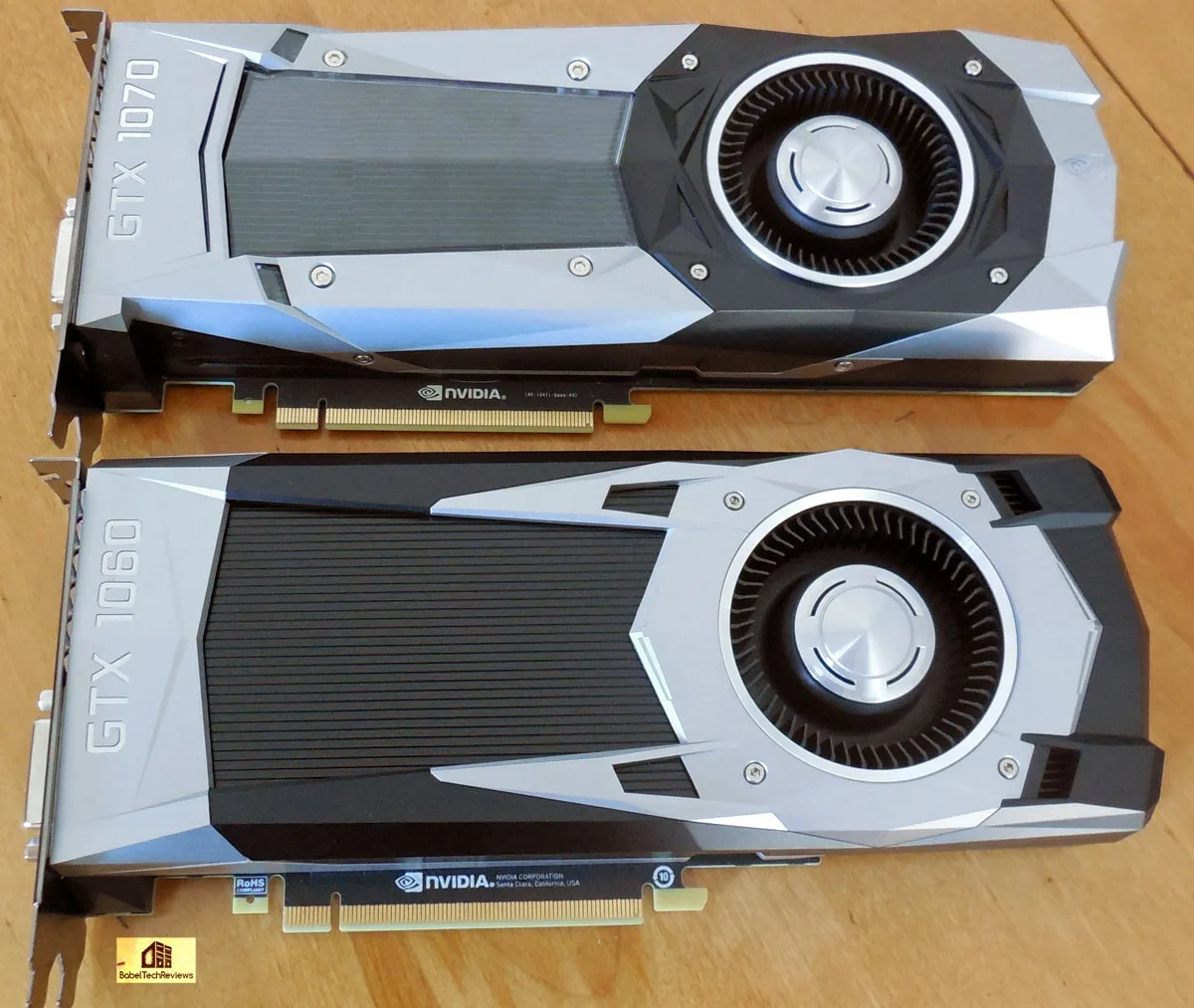 Unlike the GTX 1080 and the GTX 1070, the GTX 1060 lacks a complete backplate.
Unlike the GTX 1080 and the GTX 1070, the GTX 1060 lacks a complete backplate.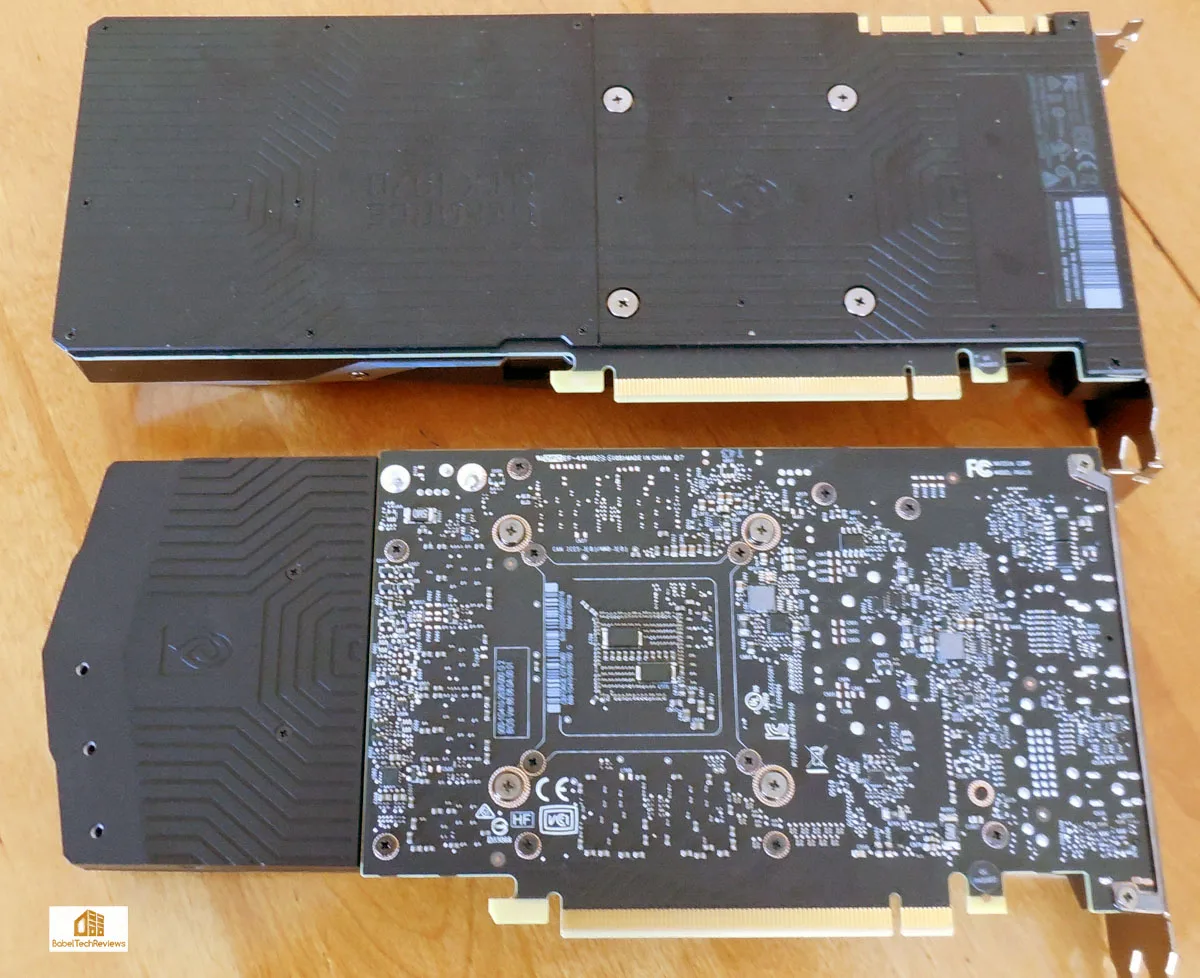
Unlike the GTX 1080 and the GTX 1070 which use a single 8-pin PCIe connector, the Founders Edition of the GTX 1060 uses a single 6-pin connector. There is also no SLI connector for the GTX 1060 as Nvidia is focusing their multi-GPU resources on the high-end GPUs like the GTX 1080 and the GTX 1070. This makes sense as many newer games do not support multi-GPU at all.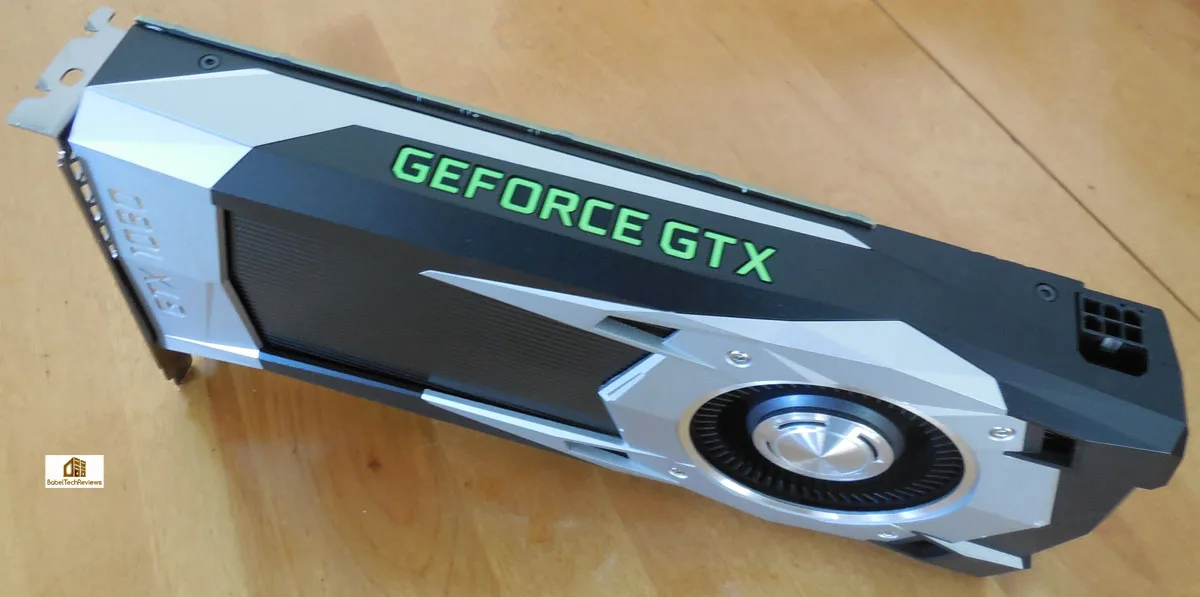
The GeForce GTX 1060 Founders Edition has been designed and built by Nvidia and it was made with premium materials and components including a faceted die cast aluminum body that definitely has a very solid feel to it. 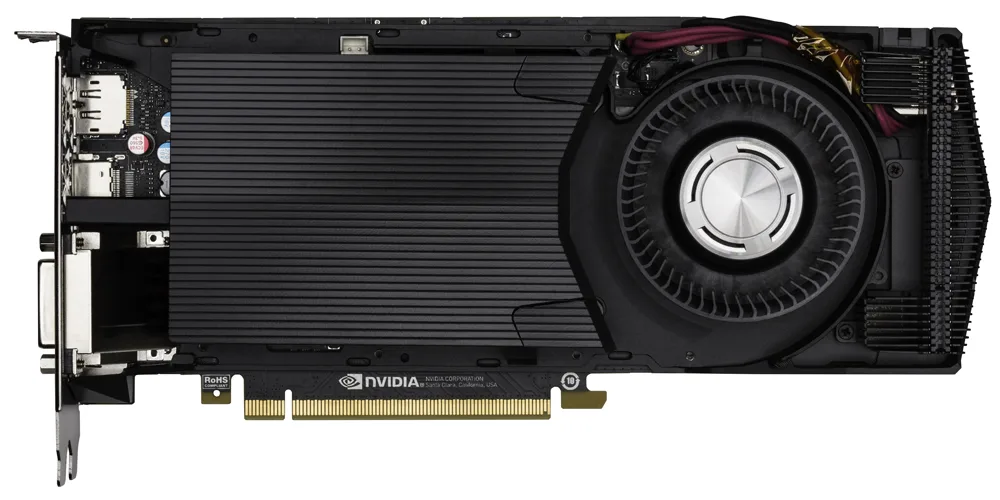 The Founders Edition is built around a radial fan and featuring two copper heat pipes embedded in the base of an aluminum heatsink, and it moves all heated air outside the chassis. The surface area of the heatsink is over 50% larger than the reference heatsink used on the GTX 960.
The Founders Edition is built around a radial fan and featuring two copper heat pipes embedded in the base of an aluminum heatsink, and it moves all heated air outside the chassis. The surface area of the heatsink is over 50% larger than the reference heatsink used on the GTX 960.
The connections are the same for all 3 Pascal cards.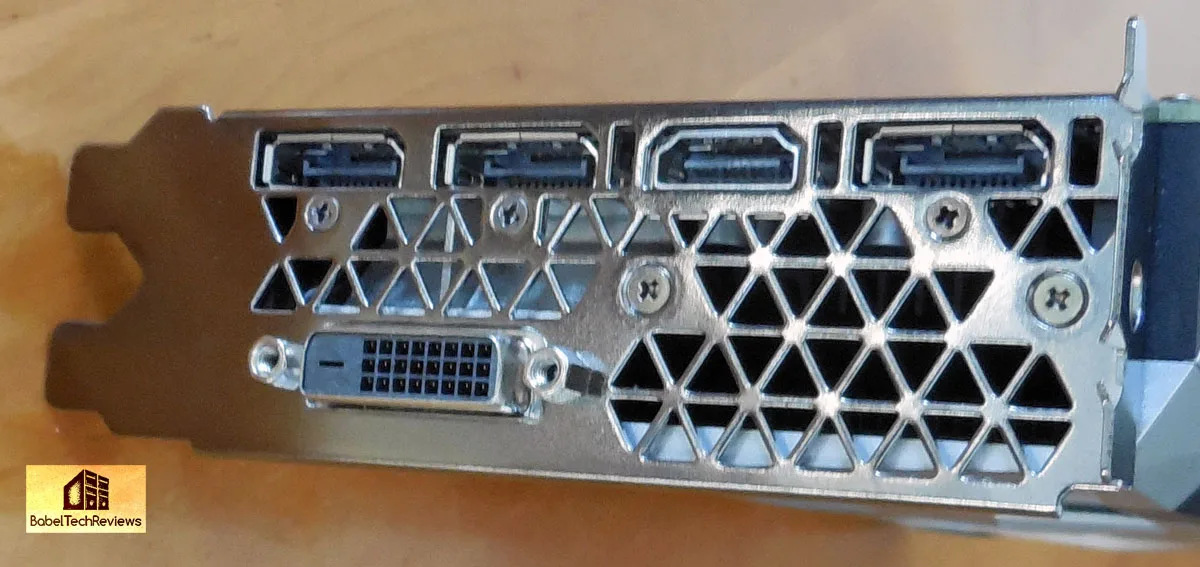
Other Features of the GTX 1060
Ansel has been Integrated into Mirror’s Edge: Catalyst and later on in the Witcher 3 this Month
The GTX 1060 also supports Nvidia Ansel technology, a game-capture tool that allows gamers to explore and share gaming art in new ways. With Ansel, users can compose their gameplay shots by pointing the camera in any direction and from any vantage point within a gaming world, and then capture 360-degree stereo photospheres for viewing with a VR headset or with Google Cardboard.
The first game to support Ansel is Mirror’s Edge: Catalyst, and Witcher 3: Wild Hunt, will be available later this month. More Ansel-supported games are in development, including Epic Games’ Fortnite, Paragon and Unreal Tournament; Cyan Worlds’ Obduction; Thekla’sThe Witness; Boss Key Productions’ Lawbreakers; Ubisoft’s Tom Clancy’s The Division; and No Man’s Sky from Hello Games.
VR Funhouse is now on Steam and adds GTX 1060 support
Nvidia VR Funhouse – the company’s VR carnival game – is now available for free from Valve’s Steam digital distribution service. Developed on Epic Games’ Unreal Engine 4, VR Funhouse will work on GTX 1080, 1070 and 1060 GPUs with HTC Vive VR headsets. It will also be open sourced to developers and artists so they can create their own VR Funhouse attractions.
Let’s check out the test configuration.
Test Configuration
Test Configuration – Hardware
- Intel Core i7-6700K (reference 4.0GHz, HyperThreading and Turbo boost is on to 4.4GHz; DX11 CPU graphics).
- ASRock Z7170M OC Formula motherboard (Intel Z7170 chipset, latest BIOS, PCIe 3.0/3.1 specification, CrossFire/SLI 8x+8x)
- G.Skill Ripjaws V 16GB DDR4 (2x8GB, dual channel at 3200MHz)
- GTX 1060 6GB, Founders Edition, stock clocks, supplied by Nvidia
- RX 480 8GB, Diamond reference version, at stock clocks (1266/1120MHz).
- GTX 1070 8GB Founders Edition, stock clocks, supplied by Nvidia
- GTX 980 4GB reference version, stock clocks, supplied by Nvidia
- GALAX GTX 970 EXOC, stock GALAX factory clocks, supplied by GALAX
- ASUS Strix GTX 960 OC 2GB, stock ASUS factory clocks, supplied by ASUS
- VisionTek, R9 290X 4GB, reference version, fan set to 100% to prevent throttling.
- Two 2TB Toshiba 7200 rpm HDDs for each platform
- EVGA 1000G 1000W power supply unit (for both platforms)
- Cooler Master 2.0 Seidon, supplied by Cooler Master (Devil’s Canyon)
- Thermaltake Water2.0, supplied by Thermaltake (Skylake)
- Onboard Realtek Audio
- Genius SP-D150 speakers, supplied by Genius
- Thermaltake Overseer RX-I full tower case, supplied by Thermaltake (Skylake)
- Thermaltake Chaser II, full tower case, supplied by Thermaltake (Devil’s Canyon)
- ASUS 12X Blu-ray writer
- Monoprice Crystal Pro 4K
Test Configuration – Software
- Nvidia’s GeForce 368.64 GTX 1060 launch drivers were used for all Nvidia cards. High Quality, prefer maximum performance, single display.
- AMD Crimson Software 16.7.2 beta hotfix drivers were used for benching the RX 480 and the 290X.
- VSync is off in the control panel.
- AA enabled as noted in games; all in-game settings are specified with 16xAF always applied
- All results show average frame rates including minimum frame rates shown in italics on the chart next to the averages in smaller font.
- Highest quality sound (stereo) used in all games.
- Windows 10 64-bit Home edition, all DX11 titles were run under DX11 render paths. Our four DX12 titles are run under the DX12 render path. Latest DirectX
- All games are patched to their latest versions at time of publication.
- Crimson Software’s WattMan was used for the RX 480.
- EVGA’s Precision XOC, reviewer’s version 6 used for Nvidia cards.
-
The 26 PC Game benchmark suite & 2 synthetic tests
Synthetic
- Firestrike – Basic & Extreme
- Time Spy DX12
- Crysis 3
- Metro: Last Light Redux (2014)
- GRID: Autosport
- Middle Earth: Shadows of Mordor
- Alien Isolation
- Dragon’s Age: Inquisition
- Dying Light
- Total War: Attila
- Grand Theft Auto V
- ProjectCARS
- the Witcher 3
- Batman: Arkham Origins
- Mad Max
- Fallout 4
- Star Wars Battlefront
- Assassin’s Creed Syndicate
- Just Cause 3
- Rainbow Six Siege
- DiRT Rally
- Far Cry Primal
- Tom Clancy’s The Division
- DOOM (*OpenGL & Vulkan)
- Mirror’s Edge Catalyst
DX12 Games
- Ashes of the Singularity
- Hitman
- Rise of the Tomb Raider
- Total War: Warhammer
Nvidia’s Control Panel settings:
Here are the settings that we always use in AMD’s Crimson Control Center for our default benching. They are identical settings to what we used in the older Catalyst Control Center. The Power Efficiency Toggle is left off in our benching.
This time, with the latest Crimson 16.7.2 drivers, we were able to set our RX 480’s Power Limit to +50% and also assign a maximum Temperature Limit which improved performance over the launch 16.6.2 drivers.
Let’s check out overclocking and noise.
Overclocking and noise
The GTX 1060, like the GTX 1070, are very quiet cards even when overclocked. We did not get to spend more than a few minutes with the new Precision XOC and we did not use its automatic overclocking scanner but instead settled on a core offset of +200MHz and +700MHz added to the memory clocks. This is a very preliminary overclock that will be fine tuned in a follow up evaluation pitting the overclocked GTX 1060 versus the overclocked RX 480 and versus the overclocked GTX 980.
Here are the settings we used at idle. Although we never adjusted the voltage or the automatic fan profile, we set the Power and Temperature targets to their maximum (116% and 92C).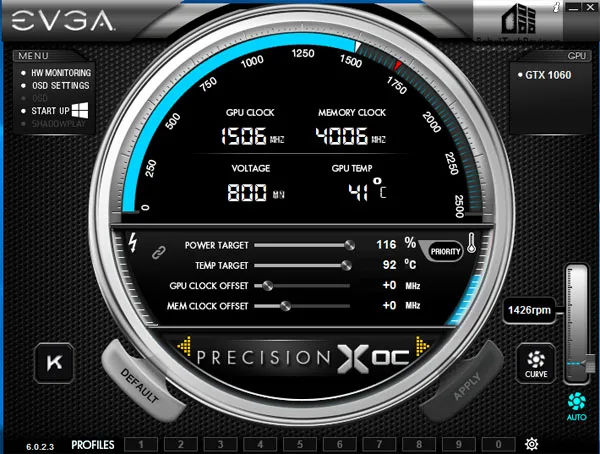
Let’s look at a series of screen shots using Precision XOC starting with completely stock values and moving up to our highest stable Heaven 3.0 overclock, and compare the GPU 3.0 Boost clocks, memory clocks, temperatures, throttling, and fan profile. As we loop Heaven continually at 2560×1440 in a window, we first start with everything completely at default stock settings (with Power/Temp targets to maximum).
These are the results after our first Heaven 3.0 loop with the temperature settling in at 73C.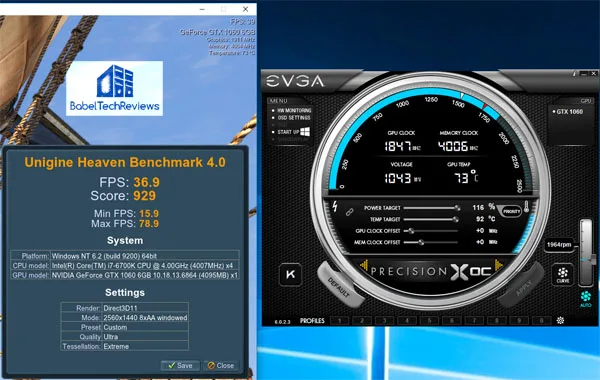
Maximum boost at absolute default (power target is 116% and temp is set to 92C; everything else is automatic) is 1847MHz when it is cool and it drops to about 1822MHz. Voltage varies from 1025mV to about 1043mV as it starts to heat up; at 73C, the boost clocks drop to an average locked-on core clock of 1822MHz. At stock values, it is pretty quiet with the fan speeds well below 2000 rpm.
Here are our results after looping Heaven 3.0 for about an hour and we see very little change.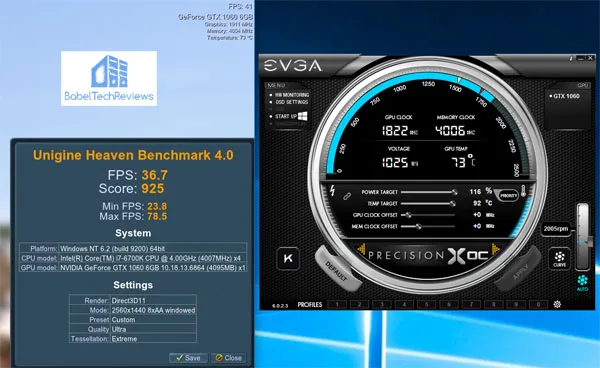
Next, we overclock the GTX 1070 to our maximum tested preliminary stable overclock in Heaven, but leave everything else on automatic – except for the Power and Temperature targets which are always left on Maximum.
We saw our boost clocks now reach and stay locked on to 2025 MHz and our memory clocks hit 4704MHz. Temperatures did not exceed 80C at any point and the voltage automatically moves up to about 1031mV.. The fan is more noticeable at 2150 rpm, but still decently quiet at our maximum overclock. And of course, the performance in Heaven 3.0 increases significantly with this overclock. We added no extra voltage and the fan profile was left on automatic and we never saw any throttling!
Performance scaling with 6 Games
We only tested five DX12 games at our maximum preliminary overclock at stock voltage and fan profile.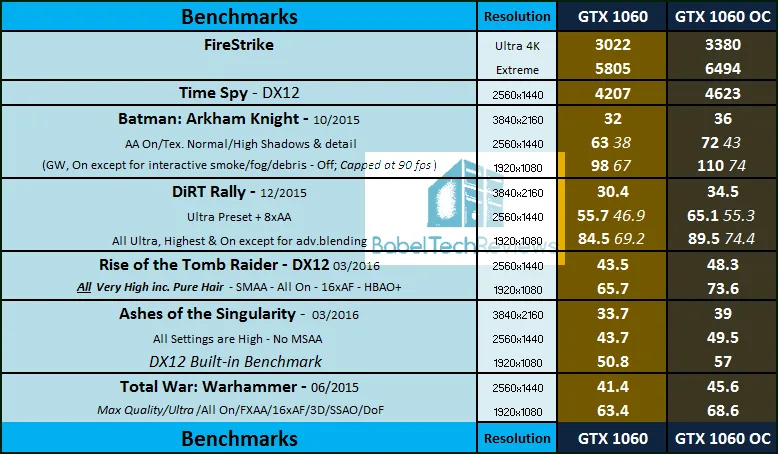
We can conclude that the GTX 1060 scaling is decent with a solid preliminary overclock. We will test overclocking the GTX 1060 with the updated Precision XOC further in an evaluation devoted to maximum overclocking of the GTX 1060 versus the RX 480 and versus the GTX 980 next week. In that evaluation, we may well crank up and fine tune the voltage and increase the fan profiles to give an even higher set of overclocks.
Let’s check out the performance charts.
Performance summary charts
Here are the summary charts of 26 games and 1 synthetic test. The highest settings are always chosen and it is usually DX11; DX12 is picked above DX11 where available, and the settings are ultra or maxed. Specific settings are listed on the performance charts. The benches were run at 1920×1080, 2560×1440, and at 3840×2160.
All results, except for FireStrike and Time Spy, show average framerates and higher is always better. Minimum frame rates are shown when they are available and they make sense, next to the averages but they are in italics and in a slightly smaller font. In-game settings are fully maxed out and they are identically high or ultra across all platforms. “NA” means the benchmark could not be run. “X” means the benchmark was not run, and an asterisk (*) means there were some major issues with the visuals.
The GTX 1070 generally wins every game benchmark followed generally by the GTX 980, and closely by the GTX 1060. The RX 480 wins a few and trades blows with the GTX 1060 in several games, but it is generally slower, although it is a bit faster than the 290X; and they are all generally faster still than the GTX 970 OC. We can also see that GTX 1060 is significantly faster than the overclocked GTX 960 from the previous generation – the 2GB vRAM-equipped card from early 2015 cannot even run every game at the ultra settings that we use.
DOOM Testing with Vulkan vs. OpenGL
Since DOOM has no built-in benchmark, we can only load up a single scene where the framerates are consistent and give rough averages. Here are our test cards comparing OpenGL performance to the Vulkan API.
As we can see, Nvidia’s OpenGL drivers are far more efficient than AMD’s. However, Vulkan does not appear at all optimized for Nvidia cards since their OpenGL performance is consistently faster. In the case of the GTX 980, Nvidia’s OpenGL performance is faster than AMD’s RX 480 or 290X performance using the otherwise more efficient Vulkan API.
The GTX 1060 vs. the RX 480 and vs. the GTX 980
Here is the GTX 1060 compared with AMD’s new Polaris architecture card, the RX 480, with the GTX 980 results also added.
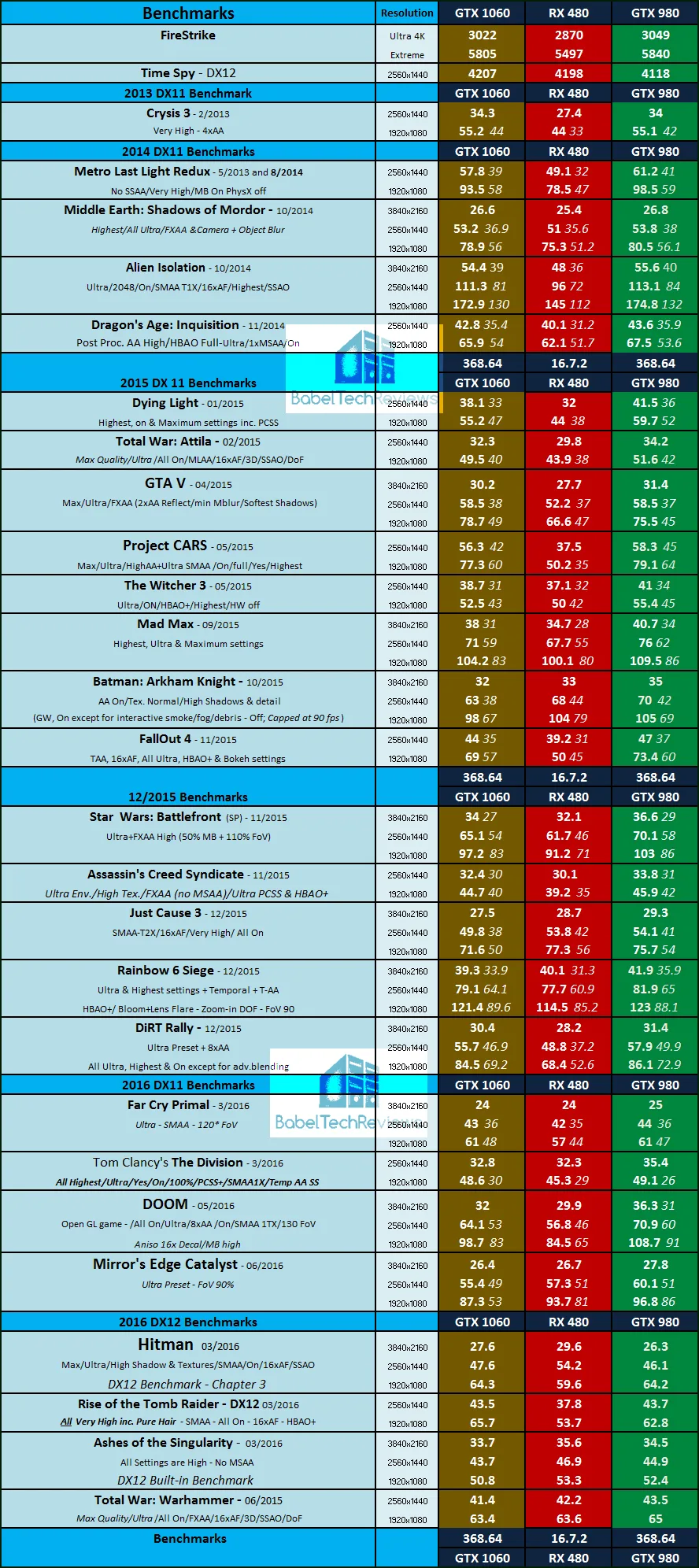 We see that the GTX 1060 is generally faster than the RX 480 although the RX 480 trades blows in some games and wins in a few others. Since the RX 480 has significantly improved performance since its launch with new drivers and setting a new maximum Power Limit over stock values, we cannot confirm Nvidia’s claim of the GTX 1060 being 15% faster – however it is faster. And we also found that the GTX 980 is somewhat faster than the GTX 1060.
We see that the GTX 1060 is generally faster than the RX 480 although the RX 480 trades blows in some games and wins in a few others. Since the RX 480 has significantly improved performance since its launch with new drivers and setting a new maximum Power Limit over stock values, we cannot confirm Nvidia’s claim of the GTX 1060 being 15% faster – however it is faster. And we also found that the GTX 980 is somewhat faster than the GTX 1060.
What about Nvidia’s Claim that the GTX 1060 is as fast as the GTX 980?
The reason we find that in our benchmarks the GTX 980 is a little faster than the GTX 1080 is because of how we run them. We found the GTX 980 to be consistently faster than the GTX 1060 is because of the way that we have always benchmarked video cards. We always set the Power and Temperature limits to their maximum and have thus never had any issues with throttling, and have had consistent results with our benching. However, the GTX 1060 does not benefit very much performance-wise by this setting although the GTX 980 certainly does.
Overclocking
Let’s head for our conclusion.
Conclusion
This has been quite an enjoyable exploration for us in evaluating the new GTX 1060 Founders Edition. It did well performance-wise comparing it to the GTX 980 where it trades blows with the more expensive GTX 980 Maxwell generation card, and it beats the GTX 970 OC. And it is a blowout in favor of the new GTX 1060 compared with its predecessor, the GTX 960 OC. The GTX 1060 beats its AMD competitor, the RX 480 in stock benching and it is a blowout if you consider overclocking as the reference version barely managed 3-5% over its reference clocks at stock settings.
We are totally impressed with this mid-level performance single 6-pin PCIe cabled Pascal chip that has such good overclockability and an excellent price. Priced beginning at $249, and at $299 as tested, the GTX 1060 does well in price to performance compared with the more expensive GTX 980 and against the similarly priced GTX 970. If you value power efficiency, the GTX 1060 is also a better deal, performing above the $239 RX 480, and it offers more advantages and new features for its price compared with similarly priced Maxwell GPUs. The reference/Founders Edition GTX 1070 is intended as a better than entry-level VR budget card and it brings good value at $249-299.
As the GTX 1060 is an ideal card for 1920×1080, it has been priced between $249 to $299 to slot well below the GTX 980’s current price range and it is price competitive with the GTX 970 even though it is more powerful. We see good overclockability with quietness at stock voltage and fan profile from the reference/Founders Edition design GTX 1060.
Pros
- TDP and power draw is almost unbelievable at 120W for such high-performance from an upper-midrange GPU, using only one 6-pin PCIe cable; in contrast the reference RX 480 requires 150W and cannot overclock nearly as well.
- Overclockability is very good and GPU Boost 3.0 works with the Precision XOC overclock utility to further fine-tune overclocks.
- The reference design cooling is quiet and efficient; the card stays cool even well-overclocked on a hot Summer-like day.
- VR becomes very possible with the GTX 1060 with Simultaneous Multi-projection.
- GameWorks brings new features to gaming and to VR.
- New Fast Sync allows for high performance decoupling from the monitor, without tearing at very high frame rates.
- Pricing is good as it has launched near GTX 970 pricing and far below GTX 980 pricing. The GTX 1060 beats the overclocked GTX 970 and come very near to GTX 980 performance.
- There is a solid feel to the Founders Edition and the industrial design is eyecatching.
Cons
- None. Perhaps the Founders Edition $299 pricing is an issue compared with Nvidia’s partner GTX 1060s beginning at $249 if you look at performance alone.
The Verdict:
 If you are buying a fast video card right now and looking for good performance for a better than entry-level VR or for maxed out 1080P gaming, the GTX 1060 is an excellent choice since the GTX 980 is more expensive. The GTX 1060 beats its competition the reference RX 480 at stock, it overclocks better, and it uses less power.
If you are buying a fast video card right now and looking for good performance for a better than entry-level VR or for maxed out 1080P gaming, the GTX 1060 is an excellent choice since the GTX 980 is more expensive. The GTX 1060 beats its competition the reference RX 480 at stock, it overclocks better, and it uses less power.- We would like to award the Founder’s Edition of the GTX 1070 the BabelTechReviews Editor’s Choice Award.
We do not know what the future will bring, but the GTX 1060 brings a superb performer to the Pascal GeForce family now. With great forward looking features, you can be assured of immersive gaming by picking this card for 1920×1080 or even 2560×1440, and especially for better than entry-level VR.
If you currently game on an older video card, even like the last generation GTX 960, you will do yourself a big favor by upgrading. The move to a GTX 1060 will give you better visuals and performance on the DX11 and DX12 pathways.
AMD offers their own set of features including Eyefinity and GCN 2.0. However, Polaris is less power-efficient architecture and the reference version of the RX 480 at $239 is a poor overclocker. AMD is concentrating on their midrange and we hope to bring you reviews of their partner RX 480s which should be be better overclockers, and also of their upcoming lower-midrange cards.
Stay tuned, there is a lot coming from us at BTR. Next, we will test the GTX 1060 maximum overclocking with the latest Precision XOC versus the maximum overclocked GTX 980 and versus the maximum overclocked RX 480.
Happy Gaming!
